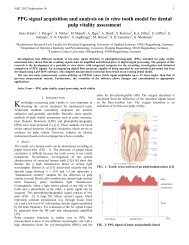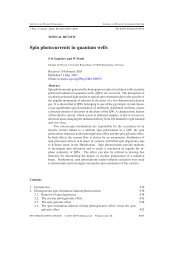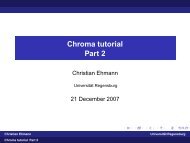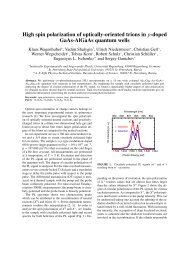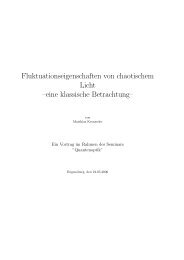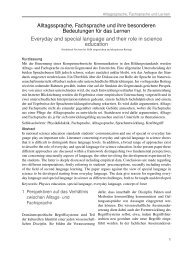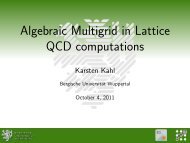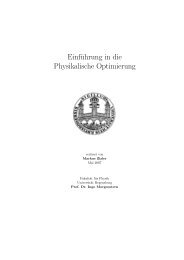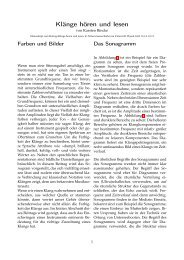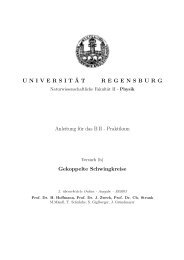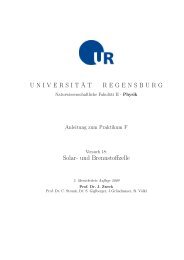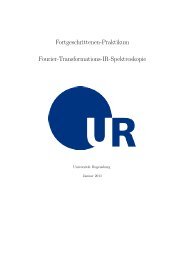Undulation instabilities in laterally structured magnetic multilayers
Undulation instabilities in laterally structured magnetic multilayers
Undulation instabilities in laterally structured magnetic multilayers
You also want an ePaper? Increase the reach of your titles
YUMPU automatically turns print PDFs into web optimized ePapers that Google loves.
JOURNAL OF APPLIED PHYSICS VOLUME 91, NUMBER 10 15 MAY 2002<br />
<strong>Undulation</strong> <strong><strong>in</strong>stabilities</strong> <strong>in</strong> <strong>laterally</strong> <strong>structured</strong> <strong>magnetic</strong> <strong>multilayers</strong><br />
T. Eimüller a)<br />
MPI Für Metallforschung, Heisenbergstrasse 1, 70569 Stuttgart, Germany and Exp. Physik IV,<br />
Universität Würzburg, Am Hubland, 97074 Würzburg, Germany<br />
M. Scholz<br />
Exp. und Angew. Physik, Universität Regensburg, 93040 Regensburg, Germany<br />
P. Guttmann<br />
Institut für Röntgenphysik, Universität Gött<strong>in</strong>gen c/o BESSY, Albert-E<strong>in</strong>ste<strong>in</strong>-Strasse 15,<br />
12489 Berl<strong>in</strong>, Germany<br />
M. Köhler and G. Bayreuther<br />
Exp. und Angew. Physik, Universität Regensburg, 93040 Regensburg, Germany<br />
G. Schmahl<br />
Institut für Röntgenphysik, Universität Gött<strong>in</strong>gen, Geiststrasse 11, 37073<br />
P. Fischer and G. Schütz<br />
MPI für Metallforschung, Heisenbergstrasse 1, 70569 Stuttgart, Germany and Exp. Physik IV,<br />
Universität Würzburg, Am Hubland, 97074 Würzburg, Germany<br />
<strong>Undulation</strong> <strong><strong>in</strong>stabilities</strong> of <strong>magnetic</strong> doma<strong>in</strong>s have been observed <strong>in</strong> nano<strong>structured</strong> strips of a<br />
ferro<strong>magnetic</strong> Fe/Gd multilayer. The novel technique of <strong>magnetic</strong> transmission x-ray microscopy,<br />
which is based on the x-ray <strong>magnetic</strong> circular dichroism, was used for imag<strong>in</strong>g. Below a critical<br />
<strong>magnetic</strong> field, s<strong>in</strong>us-like modulations of the <strong>magnetic</strong> doma<strong>in</strong>s could be observed. At a higher rate<br />
of field <strong>in</strong>duced stra<strong>in</strong> rectangular patterns occur. They seem to be characteristic for the reduced<br />
lateral width of the <strong>magnetic</strong> system and are <strong>in</strong> contrast to chevron patterns observed <strong>in</strong> extended<br />
systems. The doma<strong>in</strong> morphologies found <strong>in</strong> different <strong>magnetic</strong> fields H, and <strong>in</strong> nanowires of<br />
various widths L z , have been summarized <strong>in</strong> a H – L z ‘‘phase’’ diagram. An analogy with theoretical<br />
predictions for extended systems could be found. © 2002 American Institute of Physics.<br />
DOI: 10.1063/1.1452682<br />
INTRODUCTION<br />
The competition of short-range attractive and long-range<br />
repulsive <strong>in</strong>teractions gives rise to modulated doma<strong>in</strong> morphologies<br />
<strong>in</strong> a variety of condensed matter systems. A second<br />
modulation perpendicular to the orig<strong>in</strong>al layer normal occurs,<br />
if these systems are triggered by mechanical, temperature,<br />
or field <strong>in</strong>duced stra<strong>in</strong>. Such buckl<strong>in</strong>g or undulation<br />
<strong><strong>in</strong>stabilities</strong>, form<strong>in</strong>g s<strong>in</strong>usoidal or chevron patterns, could be<br />
found <strong>in</strong> smectic liquid crystals, 1<br />
ferro<strong>magnetic</strong> garnet<br />
films, 2,3 <strong>magnetic</strong> fluids, 4 or <strong>in</strong> cholesteric mixtures. 5 We report<br />
on the observation of undulation <strong><strong>in</strong>stabilities</strong> <strong>in</strong> nano<strong>structured</strong><br />
strips of a ferro<strong>magnetic</strong> Fe/Gd multilayer by<br />
<strong>magnetic</strong> transmission x-ray microscopy MTXM.<br />
EXPERIMENTAL DETAILS<br />
A (4 ÅFe/4 ÅGd)75 multilayer has been prepared by<br />
dc magnetron sputter<strong>in</strong>g on top of a 30-nm-thick Si 3N 4<br />
membrane ensur<strong>in</strong>g a sufficiently high transmission <strong>in</strong> the<br />
soft x-ray range. The film was protected aga<strong>in</strong>st corrosion by<br />
an 8-nm-thick Al layer. Electron beam lithography was used<br />
to structure the system. The pattern has thereby been transferred<br />
from a polymethylmethacrylate layer to an Al 2O 3<br />
film, serv<strong>in</strong>g as a mask for ion beam etch<strong>in</strong>g. This two-step<br />
a Electronic mail: thomas.eimueller@physik.uni-augsburg.de<br />
procedure enhances the sharpness of the edges. Strips of different<br />
widths L z , between 2 m and 100 nm have been<br />
generated. The <strong>magnetic</strong> behavior of the equivalent un<strong>structured</strong><br />
system has been studied previously. 6 Measurements<br />
with a torque magnetometer revealed an easy axis of magnetization<br />
direct<strong>in</strong>g 60° out of the sample plane.<br />
The novel technique of <strong>magnetic</strong> transmission x-ray<br />
microscopy 7 was used to image the field dependent evolution<br />
of <strong>magnetic</strong> doma<strong>in</strong>s. The method is based on transmission<br />
x-ray microscopy TXM and utilizes the x-ray <strong>magnetic</strong> circular<br />
dichroism, i.e., the dependence of the absorption of<br />
circularly polarized x rays on the projection of the magnetization<br />
onto the photon propagation direction. This effect<br />
serves as a large and element-specific <strong>magnetic</strong> contrast that<br />
allows imag<strong>in</strong>g of <strong>magnetic</strong> doma<strong>in</strong>s <strong>in</strong> a quantitative way, <strong>in</strong><br />
vary<strong>in</strong>g external <strong>magnetic</strong> fields, and with a lateral resolution<br />
down to about 25 nm. 6–9 The images presented here are<br />
taken at the Fe L 3 edge with the full field TXM at BESSY I<br />
<strong>in</strong> Berl<strong>in</strong>, 10 us<strong>in</strong>g a zone plate, able to dist<strong>in</strong>guish feature<br />
sizes of 30 nm.<br />
RESULTS AND DISCUSSION<br />
Four typical states of the magnetization reversal are presented<br />
<strong>in</strong> Fig. 1. Each image Figs. 1a–1d shows two adjacent<br />
nanowires, each L z670 nm wide. Before imag<strong>in</strong>g<br />
the sample was saturated <strong>in</strong> a <strong>magnetic</strong> field of H<br />
0021-8979/2002/91(10)/7334/3/$19.00 7334<br />
© 2002 American Institute of Physics<br />
Downloaded 28 Jun 2002 to 132.199.101.151. Redistribution subject to AIP license or copyright, see http://ojps.aip.org/japo/japcr.jsp
J. Appl. Phys., Vol. 91, No. 10, 15 May 2002 Eimüller et al.<br />
FIG. 1. <strong>Undulation</strong> <strong>in</strong>stability <strong>in</strong> nanowires of 670 nm width. With decreas<strong>in</strong>g<br />
<strong>magnetic</strong> field, straight stripe doma<strong>in</strong>s, visible as dark and light zones <strong>in</strong><br />
both strips a accumulate stra<strong>in</strong> and undergo a buckl<strong>in</strong>g <strong>in</strong>stability. Thereby<br />
the ‘‘dark’’ stripe breaks open marked <strong>in</strong> b and forms a wavelike pattern<br />
c, which transforms <strong>in</strong>to a rectangular modulation <strong>in</strong> d.<br />
1.75 kOe, applied perpendicular to the film plane. Lower<strong>in</strong>g<br />
the field, three nearly parallel stripe doma<strong>in</strong>s with an<br />
<strong>in</strong>itial periodicity P 0 appear at H nuc , as can be seen <strong>in</strong> Fig.<br />
1a. With decreas<strong>in</strong>g external field, H, the equilibrium periodicity,<br />
P(H), is expected to decrease. 11 Thus, new stripes<br />
should nucleate to m<strong>in</strong>imize the total free energy of the system.<br />
Indeed, a second ‘‘dark’’ band can be observed, e.g., <strong>in</strong><br />
the upper part of Figs. 1c and 1d. However, <strong>in</strong> areas<br />
where the <strong>in</strong>jection of new stripes is hampered by energy<br />
barriers, e.g., by p<strong>in</strong>n<strong>in</strong>g centers, 8 the pattern accumulates a<br />
dilative stra<strong>in</strong> 1P(H)/P 0. Theories for extended<br />
systems use this stra<strong>in</strong> to expla<strong>in</strong> undulation<br />
<strong><strong>in</strong>stabilities</strong>. 12–14 Beyond that, a buckl<strong>in</strong>g pattern can also be<br />
generated by compressive stra<strong>in</strong>, 14 e.g., <strong>in</strong>duced by dipolar<br />
repulsions.<br />
As shown <strong>in</strong> the tagged part of Fig. 1b, the dark stripe<br />
breaks open at H750 Oe, mark<strong>in</strong>g the onset of undulation<br />
<strong>in</strong>stability: Below a critical field H u a wavelike pattern can<br />
be observed. With a further decreas<strong>in</strong>g field the amplitude of<br />
this pattern <strong>in</strong>creases cont<strong>in</strong>uously, while simultaneously its<br />
wavelength decreases. Fig. 1c presents the system at H<br />
565 Oe, which is well below H u . F<strong>in</strong>ally, if H falls below<br />
H sr , a rectangular modulation can be observed, as shown <strong>in</strong><br />
Fig. 1d. Concomitantly, <strong>in</strong> more and more areas the system<br />
can realize the equilibrium state, show<strong>in</strong>g two parallel dark<br />
stripe doma<strong>in</strong>s. Whereas s<strong>in</strong>usoidal undulations could previously<br />
be observed <strong>in</strong> cont<strong>in</strong>uous <strong>magnetic</strong> garnet films, 2,3 the<br />
rectangular pattern seems to be characteristic for the reduced<br />
width L z of the <strong>structured</strong> system.<br />
The undulation amplitude, u 0 , measured as an average<br />
of the maximum excursions of the center of the reversed<br />
stripe doma<strong>in</strong>s on different parts of the sample, is presented<br />
<strong>in</strong> Fig. 2 as a function of the external <strong>magnetic</strong> field, H. The<br />
field axis is plotted <strong>in</strong> reverse order to show the rise of stra<strong>in</strong><br />
from left to right. In the field range of the straight stripe<br />
doma<strong>in</strong>s the amplitude is zero. It starts to <strong>in</strong>crease at the<br />
undulation <strong>in</strong>stability field H u800 Oe. In the whole region<br />
of s<strong>in</strong>us-like undulation the amplitude rises cont<strong>in</strong>uously<br />
with decreas<strong>in</strong>g <strong>magnetic</strong> field. However, at the transition<br />
from s<strong>in</strong>us-like to rectangular modulation the slope of the<br />
u 0(H) curve decreases to nearly zero. The k<strong>in</strong>k <strong>in</strong> the slope<br />
has been used to def<strong>in</strong>e the transition field H sr . Reversibility<br />
7335<br />
FIG. 2. Amplitude of the undulat<strong>in</strong>g doma<strong>in</strong>s <strong>in</strong> strips of 670 nm width as a<br />
function of the applied <strong>magnetic</strong> field. Squares mark values taken with decreas<strong>in</strong>g<br />
field, triangles correspond to values taken with <strong>in</strong>creas<strong>in</strong>g field. A<br />
reversible behavior can be observed.<br />
of buckl<strong>in</strong>g has been studied <strong>in</strong> a field cycle 1005 Oe<br />
→625 Oe→765 Oe. Values taken with <strong>in</strong>creas<strong>in</strong>g field, i.e.,<br />
decreas<strong>in</strong>g stra<strong>in</strong>, are plotted as open triangles. They follow<br />
the curve, taken with decreas<strong>in</strong>g field, thus show<strong>in</strong>g that the<br />
rise of the undulation amplitude is completely reversible up<br />
to a certa<strong>in</strong> value of stra<strong>in</strong>.<br />
The transition from s<strong>in</strong>us-like to rectangular modulation<br />
is further visible <strong>in</strong> the <strong>magnetic</strong> field dependence of the<br />
buckl<strong>in</strong>g wavelength . As shown <strong>in</strong> Fig. 3, for strips with<br />
L z670 nm triangular data po<strong>in</strong>ts and for strips with L z<br />
600 nm rectangular data po<strong>in</strong>ts, the undulation period <br />
decreases with decreas<strong>in</strong>g <strong>magnetic</strong> field. In the field range<br />
of rectangular modulations reaches a shallow m<strong>in</strong>imum at<br />
about zero <strong>magnetic</strong> field and <strong>in</strong>creases with further decreas<strong>in</strong>g<br />
field.<br />
<strong>Undulation</strong> <strong><strong>in</strong>stabilities</strong> with an analogous behavior<br />
could also be observed <strong>in</strong> strips of L z600 nm, 460 nm, and<br />
400 nm width. The dependence of the doma<strong>in</strong> morphology<br />
on the external <strong>magnetic</strong> field and the width of the strips L z<br />
is summarized <strong>in</strong> a H – L z ‘‘phase’’ diagram, shown <strong>in</strong> Fig. 4.<br />
The decrease of the nucleation field H nuc with decreas<strong>in</strong>g L z<br />
can be expla<strong>in</strong>ed by the reduced stray <strong>magnetic</strong> field of the<br />
smaller elements. The undulation <strong>in</strong>stability field H u and the<br />
FIG. 3. <strong>Undulation</strong> wavelength as a function of the applied <strong>magnetic</strong> field<br />
observed <strong>in</strong> nanowires of 670 nm width squares and 600 nm width triangles.<br />
Downloaded 28 Jun 2002 to 132.199.101.151. Redistribution subject to AIP license or copyright, see http://ojps.aip.org/japo/japcr.jsp
7336 J. Appl. Phys., Vol. 91, No. 10, 15 May 2002 Eimüller et al.<br />
FIG. 4. ‘‘Phase’’ diagram show<strong>in</strong>g different doma<strong>in</strong> morphologies <strong>in</strong> strips<br />
of various widths, separated by the nucleation field H nuc , the undulation<br />
field H u , and the transition field between s<strong>in</strong>us-like and rectangular modulation,<br />
H sr .<br />
transition field H sr follow this trend. Nanowires of 300 nm<br />
width and smaller show mere s<strong>in</strong>gle and lamellar doma<strong>in</strong><br />
states but no undulat<strong>in</strong>g pattern.<br />
Large strips of 2 m width reverse by nucleation of<br />
several straight stripe doma<strong>in</strong>s, not necessarily oriented parallel<br />
to the long axis of the nanowire. With decreas<strong>in</strong>g field<br />
wavelike and f<strong>in</strong>ally maze patterns occur. However, rectangularly<br />
modulated doma<strong>in</strong>s could not be observed, which<br />
<strong>in</strong>dicates that the constra<strong>in</strong>t of f<strong>in</strong>ite width of the strips plays<br />
a decisive role <strong>in</strong> generat<strong>in</strong>g this pattern.<br />
The experimental results have been compared with theoretical<br />
models. Sornette used the analogy to smectic liquid<br />
crystals to develop an effective elastic theory for ferro<strong>magnetic</strong><br />
systems. 13 A more extensive analysis has been given by<br />
S<strong>in</strong>ger. 12,14 Thereby, systems with an extension L z large compared<br />
with the doma<strong>in</strong> periodicity P 0 exhibit an undulation<br />
amplitude that is maximal at the center of the system and is<br />
zero at the borders. In contrast to such ‘‘bulk’’ systems, <strong>in</strong><br />
our nano<strong>structured</strong> system the dimension L z is nearly equal<br />
to the doma<strong>in</strong> periodicity P 0 . For this marg<strong>in</strong>al case theories<br />
do not exist thus far. Nevertheless, an analogy to buckl<strong>in</strong>g<br />
<strong><strong>in</strong>stabilities</strong> <strong>in</strong> extended systems could be found. Near H u the<br />
theories 12–14 predict a l<strong>in</strong>ear relation between the undulation<br />
period 0 and the size L z of the extended system: 0<br />
(P 0L) 1/2 N 0 1/2 Lz , where N 0 is the number of doma<strong>in</strong><br />
periods counted along L z . Likewise, between the width L z of<br />
the <strong>structured</strong> strips and the <strong>in</strong>itial undulation periodicity<br />
0 , a l<strong>in</strong>ear relation could be found, as shown <strong>in</strong> Fig. 5.<br />
Notable is the fact that the experimental data follow exactly<br />
the predicted slope for the extended system. Whereas for<br />
dilation-<strong>in</strong>duced buckl<strong>in</strong>g is expected to <strong>in</strong>crease with <strong>in</strong>creas<strong>in</strong>g<br />
stra<strong>in</strong>, for compressed-<strong>in</strong>duced buckl<strong>in</strong>g a decrease<br />
of L has been predicted, 14 <strong>in</strong> qualitative agreement with the<br />
observation. Beyond that, a comparison of the buckl<strong>in</strong>g profiles<br />
calculated for dilative and for compressive stra<strong>in</strong> 14 reveals<br />
that the compressed-<strong>in</strong>duced profile is closer to the<br />
observed rounded s<strong>in</strong>us-like shape.<br />
FIG. 5. The undulation period 0 depends l<strong>in</strong>early on the width of the<br />
strips, L z . A l<strong>in</strong>ear least squares fit of the data upper l<strong>in</strong>e shows exactly the<br />
slope of the function predicted by theory for extended systems lower l<strong>in</strong>e.<br />
To summarize, undulat<strong>in</strong>g doma<strong>in</strong> pattern of s<strong>in</strong>us-like<br />
shape could be observed by MTXM <strong>in</strong> nanowires of a ferro<strong>magnetic</strong><br />
Fe/Gd multilayer. For a large rate of stra<strong>in</strong> <strong>in</strong> the<br />
strips of reduced dimension Lz rectangular doma<strong>in</strong>s occur, <strong>in</strong><br />
contrast to chevron structures observed 1–5<br />
<strong>in</strong> and<br />
predicted 12–14 for extended systems. The undulation period<br />
behaves analogously to theoretical predictions, 12–14 and h<strong>in</strong>ts<br />
of a compressed <strong>in</strong>duced buckl<strong>in</strong>g could be found. However,<br />
an extension of the theory to the limit L z→P 0 is required to<br />
provide a comprehensive description of the observations.<br />
ACKNOWLEDGMENTS<br />
Valuable discussions with Sherw<strong>in</strong> S<strong>in</strong>ger from the Ohio<br />
State University, the technical support by BESSY, and the<br />
f<strong>in</strong>ancial support by the German Federal M<strong>in</strong>istry of Research<br />
and Technology BMBF are gratefully acknowledged.<br />
1<br />
N. A. Clark and A. J. Hurd, J. Phys. France 43, 1159 1982.<br />
2<br />
P. Molho, J. L. Porteseil, Y. Souche, J. Gouzerh, and J. C. S. Levy, J. Appl.<br />
Phys. 61, 4188 1987.<br />
3<br />
M. Seul and R. Wolfe, Phys. Rev. A 46, 75191992.<br />
4<br />
F. Elias, C. Flament, J.-C. Bacri, and S. Neveu, J. Phys. I 7, 7111997.<br />
5<br />
T. Ishikawa and O. D. Lavrentovich, Phys. Rev. E 63, 030501R 2001.<br />
6<br />
Th. Eimüller et al., J. Appl. Phys. 87, 6478 2000.<br />
7<br />
P. Fischer, T. Eimüller, G. Schütz, P. Guttmann, G. Schmahl, K. Prügl und<br />
G. Bayreuther, J. Phys. D 31, 649 1998.<br />
8<br />
T. Eimüller, P. Fischer, G. Schütz, P. Guttmann, G. Schmahl, K. Prügel,<br />
and G. Bayreuther, J. Alloys Compd. 286, 201999.<br />
9<br />
T. Eimüller et al., Appl. Phys. A: Mater. Sci. Process. 73, 6972001.<br />
10<br />
G. Schmahl, D. Rudolph, P. Guttmann, G. Schneider, J. Thieme, and B.<br />
Niemann, Rev. Sci. Instrum. Journal 66, 1282 1995.<br />
11<br />
C. Kooy and U. Enz, Philips Res. Rep. 17, 71960.<br />
12<br />
S. J. S<strong>in</strong>ger, Phys. Rev. E 48, 2796 1993.<br />
13<br />
D. Sornette, J. Phys. France 48, 1511987; 48, 14131987.<br />
14<br />
S. J. S<strong>in</strong>ger, Phys. Rev. E 62, 3736 2000.<br />
Downloaded 28 Jun 2002 to 132.199.101.151. Redistribution subject to AIP license or copyright, see http://ojps.aip.org/japo/japcr.jsp




